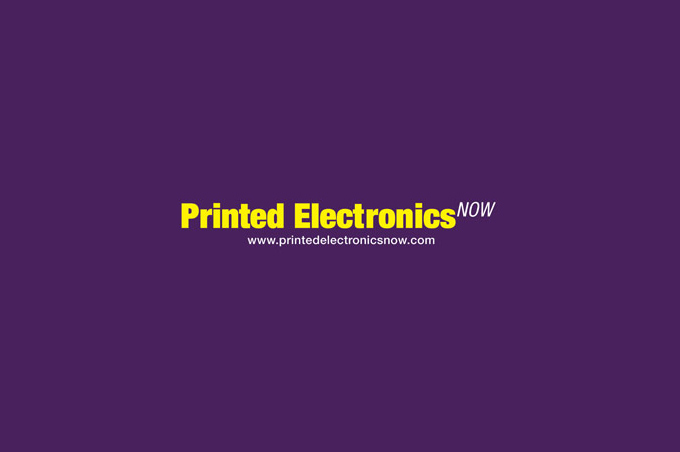Conductive inks and pastes provide critical performance characteristics for printed and flexible electronic systems. The choice of materials is varied – metallics such as silver and copper, nanoparticles, carbon nanotubes and graphene are among the more common selections – and each material offers its own advantages to the final conductive system.
For example, Roy Bjorlin, global commercial director, Electronic Materials, Sun Chemical, said that the primary materials used for manufacturing conductive inks are silver particles, resins and solvents.
“At Sun Chemical, we are focused primarily on materials that support our technology road map for advanced metallization processes, including a range of materials to support additive and subtractive processes,” Bjorlin said. “For additive processes, we offer a full range of conductive and nonconductive materials for screen, flexo, gravure, inkjet and offset printing. Subtractive materials we offer include masking resist for the production of printed antenna, and certain advanced photovoltaic applications including selective emitter and integrated back contact cells.
“Sun Chemical conductive inks are being used in a variety of manufacturing processes, including the production of displays, sensors, electronic switches, security devices, mobile phones and photovoltaic cells,” Bjorlin added.
“In our part of the industry, for conductors we are graphite, carbon and silver-based predominantly,” Terry Kaiserman, chief technical officer for T-INK, Inc., said. “We use some conductive zinc, and have used conductive polymers and some carbon nanotubes. For curing systems, we use solvent, water, UV and EB cure systems predominantly, but also have occasion to use plastisol/organosol systems. The choice depends upon the end product being produced. Offset at the moment is predominant, but screen and flexo aren’t far behind. Gravure is steadily coming back on some projects.”
Stan Farnsworth, vice president marketing for NovaCentrix, said that the leading materials being used to achieve electrical conductivity are still solid additives, primarily silver.
“The form of silver can vary from nanoparticles to micron-scale flakes, and we see a pretty large range in pricing,” Farnsworth noted. “One factor governing the type of solids used is the desired printing method. Micron-scale flakes, for example, are not suitable for use with inkjet deposition systems. Printed pattern dimensions are a second factor. Larger 10 micron-scale flakes are not suitable for 20 micron print widths.
“A third factor affecting material selection is conductive performance,” Farnsworth added. “To achieve very good sheet-resistance values (low overall pattern resistance), solid additives are historically better-performing. In addition to silver, materials such as nickel are gaining interest for specialized applications such as sensors. Carbon has long been an inks additive, and the increased interest in graphene and carbynes has sparked in increase in the development of inks intending to take advantage of the unique properties of those materials.
“Our most innovative material is the use of copper oxide,” Farnsworth said. “We have commercialized a family of inks based on the use of nano copper oxide, which has no inherent electrical conductivity when printed. The inks are formulated with a reducing agent, and after they are printed, they are processed with a PulseForge photonic curing tool. The PulseForge tool converts the copper oxide into copper. The resulting material approaches or even surpasses the performance of traditional silver inks.”
“Some companies are also commercializing non-solids-based conductive inks,” Farnsworth added. “These inks are typically better-suited for thin traces such as for bio-medical applications, sensors and sometimes display components, because of their limited current-carrying capacity.”
“Our silver nanofiber materials are being formulated into inks used to prepare transparent conductive films for touchpanels and solid state lighting,” said Allen Reid, commercial director for NANOGAP. “Our silver nanoparticle dispersions are being formulated into inks for inkjet and aerosol jet applications. We chose silver because of its very high conductivity, and our technical expertise in silver chemistry.”
Paul Lindquist, business development manager for Methode Electronics, said that for active ingredients, Methode primarily utilizes various types of nano- and micron-sized silver, and for resistive inks, nano- and micron-sized particles of carbon and graphite.
“The rest of the matrix consists of resins, additive and diluents. Methode focuses primarily on water-based chemistry, but also has solvent and UV chemistries,” Lindquist added.
Dr. Dan Harrison, senior vice president, IIMAK, said that IIMAK uses metallic flakes, conductive carbon black and graphene in the production of its conductive inks.
“The metal flakes are either pure silver or a composite flake with a core or copper and a veneer of silver,” Dr. Harrison said. “IIMAK’s conductive thermal transfer ribbon is produced with aluminum. For higher volume applications, graphene-based inks for screen printing hold the promise of driving down ink costs.
“Customers are developing many new products which require very fine line printing,” Dr. Harrison added. “For our conductive screen inks, we are moving toward smaller conductive particles to enable higher line count screens to be used so that finer conductive traces can be printed.”
“We use exclusively silver nanoparticles and we are beginning to see applications and devices that are able to take advantage of their unique properties and high conductivity,” said Greg Jablonski of PChem Associates, Inc.
“We have seen a steady increase in flexo and gravure printing processes using our inks,” Jablonski added. “While these are not the predominant print methods for printed electronics, the industry is learning how to use them to produce devices.”
Graphene is a promising material for many applications, including printed electronics. Consisting of a single layer of carbon atoms, graphene is flexible and bendable, and it offers excellent conductivity and electron mobility. Graphene can also be transparent. Graphene also is extremely strong, does not oxidize and there is no shortage of carbon, as opposed to indium.
The Graphene Flagship was recently launched by the European Union to research the possibilities and commercialization of graphene and related materials. One of Europe’s first ten-year, 1,000 million Euros Future and Emerging Technologies Flagship Projects, the Graphene Flagship consists in 11 scientific and technologic work packages, one of which targets Flexible, Stretchable and Printable Electronics.
The chair of the Executive Board of the Flagship is Andrea Ferrari, head of the Cambridge Graphene Centre (CGC) and professor of Nanotechnology at the University of Cambridge. The director is Prof. Jari Kinaret, from Chalmers University of Technology, and the chair of the Strategic Advisory Council is Nobel Prize winner Prof. Andre Geim, from Manchester University.
Prof. Ferrari said that the conformal nature of graphene is a major advantage, as is its ability to be printed using present methods.
“Indium tin oxide can be bent to an extent, but it is not fully flexible,” Prof. Ferrari said. “You can make displays that are bent but not flexible with current technologies. A challenge is that companies are using chemical vapor deposition to produce graphene films for flexible displays. This requires copper, which is expensive, as well as 800°C temperature, not suitable for direct deposition on plastic substrates.”
Prof. Ferrari noted that manufacturing through liquid phase deposition is less expensive, room temperature and easily scalable, but still needs some work to produce films competitive with ITO in terms of sheet resistance.
“Graphene can also be printed,” Prof. Ferrari added. “In 2012, the University of Cambridge was the first to show inks based on graphene could be inkjet printed. Graphene and related materials have also been shown to be printable with other techniques, such as flexo, gravure and screen. We made prototypes that can satisfy present needs, and we are quite confident we can satisfy more advanced requirements and specifications in the future.”
John Voultos, business development manager, DuPont Microcircuit Materials, said that the primary ingredient in conductive inks continues to be silver.
“However, we are starting to see new applications where fine-particle and stretchable inks are being used,” Voultos added. “Screen printing remains the primary means of applying our inks, but we are observing emerging industry trends and requests from our customers in conformable, inkjet and 3-D printing. We are collaborating with material suppliers and our customers to develop products to meet the increasingly challenging needs of the printed electronics industry.”
Beth Vasy, Operations manager, Liquid X Printed Metals, Inc., said that key materials include silver, gold and carbon along with copper, but added that there are challenges due to oxidation.
“QTC inks can range from non-conductive to fully conductive across the whole range of conductivity,” said David Lussey, founder and chief technical officer, Peratech Limited. “We get these bespoke effects by using different metals and metal oxides with specific sub-micron size morphologies.
“The printable ink form of QTC was originally only available as a screen print ink,” Lussey added. “New forms are now under trial for use on standard printing machinery which will open up a whole raft of new uses for the technology.”
“ECM’s biggest selling products are silver and carbon-based inks,” Steve Toyama of Engineered Conductive Materials (ECM) said. “Next is silver chloride and zinc inks. Primarily screen printing is used, followed by a method to apply our conductive inks to elongating substrates.”
Outlook for Conductive Materials
Ink and paste suppliers are seeing increasing demand for conductive materials in the market place.
“Overall, Sun Chemical sees tremendous growth potential for its electronic materials portfolio in supporting materials for e-packaging,” Bjorlin said. “Sun Chemical is working diligently with brand owners to develop new and innovative package enhancements for consumer, data collection, as well as security functions.”
“The demand for nanofibers for transparent conductive films is going through a step change, and there is significantly increased interest in nanoparticle systems also,” said Reid.
“ECM grew to be successful by helping customers with innovative new products and we continue to see increased demand for our inks,” Toyama said. “Our biggest selling inks are for customers who weren’t around two years ago. Our biggest selling inks in the future will be inks that we are developing now for new markets.”
“Printed electronics is expected to be the next wave in electronic manufacturing, not only reducing production costs but also enabling the creation of a whole range of new devices and applications., i.e. wearable electronics, smart packaging and the like,” said Dr. Harrison.
“We are seeing a steady increase in demand for our inks,” Jablonski said. “The challenge is to fill the opportunity pipeline with enough meaningful leads.”
“There has been an increased demand in 2013 over the previous years, both in terms of quantity as well as potential opportunities,” Lindquist said.
“We are seeing an increasing demand for our inks,” Vasy said. “Device makers are looking for a transparent conductor.”
“We continue to project strong demand for our printed electronics materials, and with improving technology and new application development, we are optimistic about the industry’s growth prospects,” Voultos said.
“QTC in all its forms has anisotropic properties which allows us to make simple but unique types of touch screens which have the capability to detect true touch pressure as well as the location of the touch,” Lussey said. “This has been a rapid area of growth for us in the last year or so.”
“NovaCentrix is seeing progress in the status of the products in development by our customers,” Farnsworth said. “As a key example, we refer to our collaboration with Muhlbauer. As was announced recently, Muhlbauer expects to release RFID production equipment incorporating the NovaCentrix PulseForge equipment and based on the use of the Metalon copper oxide reduction technology. A single installation site for such an integrated tool could consume 10,000 kilograms per year of the copper oxide reduction ink. NovaCentrix is already ramping our inks production capacity to support this type of demand.”
“There is an enormous demand for conductive inks of all types, especially in our patented areas,” Kaiserman said. “We anticipate that this trend will continue as new products roll out in 2014 and 2015.”
By David Savastano, Editor | November 7, 2014
Read full article: Printed Electronics NOW

